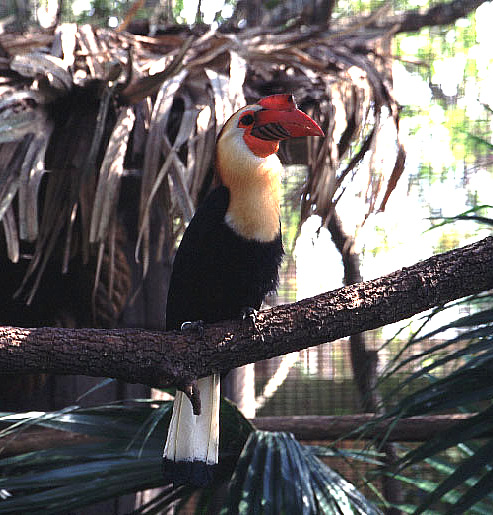 Coraciiformes Taxon Advisory Group -
Coraciiformes Taxon Advisory Group -
Writhed Hornbill (Aceros leucocephalus)
SSP Manager: Eric Kowalczyk - Woodland Park Zoo
General Information
Other common names in use include: Writhe-billed hornbill, White-headed hornbill, Wrinkled hornbill.
Description
Adult male: crown and back of neck dark brown; body and wings black, upperparts with metallic green sheen; face, front of neck, and upper breast white, later stained cream-colored with preen oils; tail white with black tip; bill, with high wrinkled red casque ridge above basal half, and blue and black grooves between ridges across base of lower mandible; bare circumorbital skin and inflatable bare throat skin bright deep orange; yellow eyelids forming ring around red eye; legs and feet dull black.
Adult female: similar to male, but smaller, with casque a high straight ridge; head and neck all black; bill slightly paler; ridges across base of lower mandible brown.
Immature: plumage like adult male for both sexes but with brown wash around the eyes and casque undeveloped; bill colored slightly paler than adult female and without clear ridges or colors at base; facial skin bright yellow, but paler than adult; eyes blue-gray; legs and feet gray. (Kemp 1995).
Status
Range
This species is found on Mindanao and surrounding islands in the Philippines where it inhabits evergreen dipterocarp forest below 1000 meters. Its requirement for primary forest, along with its wide-ranging habits and low overall density render it vulnerable. Collar, et al (1994) lists this species as endangered due to hunting and loss of habitat. Kemp (1995) implies that it is declining over most of its range, due to loss of preferred habitat. Kemp later lists this species as near threatened (in del Hoya et al 2001).
Habitat
Vocalizations
Reproduction
Current Population
The first known captive breeding of this species occurred in 1989 at Miami Metrozoo (Jung 1991). Myers (2000) wrote about the successful breeding at Audubon Park and Zoological Garden. This pair had hatched nine and fledged eight birds. Unfortunately, the breeding female died 11 May 1998. All the surviving offspring (2.2 presently) are in European collections (Parque El Retiro in Malaga, Spain and Chester Zoo in the United Kingdom). Barcena et al (in Lum & Poonswad, 2005, pp. 37-43) report! on the captive breeding at Ornithological Park El Retiro in Malaga, Spain in 2000.
San Diego Zoo had a pair of birds, the female having been captive hatched at Miami Metro Zoo in 1989. She first reproduced when she was four years old. In 1999, one chick was hand reared from this pair. There are 28 historical records. Presently there are no individuals in this region. METROZOO maintains ownership of 3 females (#23, 25, 28) that reside in Europe.
Diet



